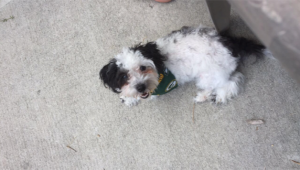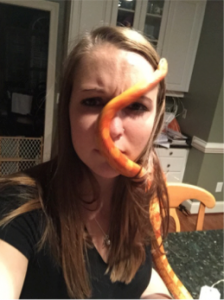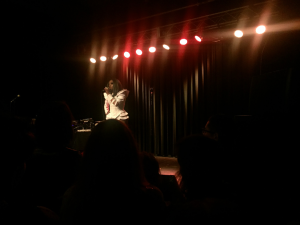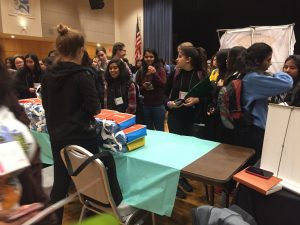By Michelle Dixon
Courtney Kohout, owner of Courtney’s Cookies, has a voice that stands with pride and confidence of who she is and what she has to offer. She knows not every customer who tastes her gluten-free organic cookies will love them, but she believes most people will.
The many days spent learning how to bake from her grandmother are evident in the soft, fluffy texture of her cookies.
But her ability to educate her customers on healthy eating comes from a different experience.
Learning from recovery
Kohout was once a teenager who ate ice cream sandwiches and cheesecakes. Out of guilt, she stuck her finger in her throat to force herself to throw up the cheesecake she ate.
“That’s twisted to say,” Kohout said. “But it tasted good after I threw it up. It was sweet and creamy.”
Kohout struggled with an eating disorder from middle school to college. But after overcoming the disorder, Kohout used her knowledge of healthy eating and baking to create Courtney’s Cookies, a business that uses organic ingredients to create vegan gluten-free cookies.
At 8 years old, Kohout was diagnosed with precocious puberty, a condition that caused her bones to overdevelop. Once a month, her dad’s mother, who was a nurse, injected her with hormones to counteract the growth of her bones.
Over time, she gained weight from the symptoms of the injections, but, at that age, she wasn’t bothered by her weight. When her attention directed to boys in middle school, her size mattered.
Like many other girls, she spent her time drawing hearts around the names of cute boys in her diary. But she believed her weight prevented any boy from noticing her.
So, she would eat one ice cream sandwich for the whole day and tell her mother she ate dinner at school. Desserts and treats replaced her meals, while her size remained the same. Kohout said she weighed 140 pounds and was overweight. Her thick curly hair was the only part of her that was thinning.
She found a new diet in high school that required her to eat 40 percent protein, 30 percent carbs and 30 percent fat. Her size went down, and boys, who once saw her as invisible, started to notice her.
But her health was still unstable. Kohout was now obsessed with memorizing nutritional facts and counting the amount of calories in her food.
“Do you know how many calories are in a cheesecake from Cheesecake Factory?” Kohout said. With her eyes widened, she said over 800 calories and 100 grams of carbs.
“Knowing what I knew about nutrition, I was just like ‘I can’t keep that inside my body,’” Kohout said.
Kohout would throw it up any junk food she ate. At one point, she didn’t need to use her fingers to vomit. “I could just make it happen,” she said.
Returning home
When Kohout attended college in Miami, her emotional health declined even more. After graduation, she returned home to Ohio and searched for a holistic way to achieve a healthy lifestyle. For an entire summer, she learned about different diets and decided her version of a healthy lifestyle would be eating what she wanted in moderation.
“I spent all of those years being restrictive, and I just couldn’t live like that anymore,” Kohout said. “I couldn’t be afraid of food anymore.”
When she moved back to Miami, she worked as a health coach for Liana Werner-Gray, author of “The Earth Diet.” Kohout said Werner-Gray asked her to promote a Spanish flour called tigernut.
Kohout used the baking skills she learned as a child to experiment with this new flour. Kohout’s mother, Susie Kohout, said Courtney spent hours cooking with her grandmother. Kohout said her grandmother lives in the house behind her parents’ home, so she would invite Kohout to make cookies with her. She said her grandmother was like Mother Teresa in the kitchen, always patient with her as a beginner.
Her grandmother passed on the knowledge of cooking to Kohout’s mom and her aunts. “I think my grandma has this idea of ‘You’re part of this family, so you’re going to cook,’” Kohout said.
A healthy twist on an old recipe
Under her grandmother’s guidance, Kohout learned how to bake chocolate chip cookies with basic ingredients: white flour, white sugar, eggs and butter. But Kohout wanted Courtney’s Cookies to be different from traditional chocolate chip cookies and the flavorless taste of gluten-free cookies. So, she used the tigernut flour as a substitute for white flour and mixed together oat flour, vanilla, chocolate chips and other ingredients to create a smooth, thick dough.
Regular dough is thinner and has no substance because of refined ingredients, but her dough retains its wholesome consistency, she said. The finished product is a nutrient-packed cookie that leaves behind sweet subtle traces of vanilla and chocolate on the tongue.
Marley Palmer, Kohout’s former roommate, said she needed only one cookie to experience full satisfaction. Palmer said the rich smell of Kohout’s cookies would infiltrate every corner of their apartment. She said her friends, who lived next door, could smell the cookies from their apartment and would ask Palmer to bring some over.
Most people who tasted her cookies urged Kohout to start a cookie business, but the intense labor of starting a business discouraged her from trying. Meanwhile, her fiance, Frank Leon, was also considering the risks of helping her develop the business, but he trusted in Kohout’s cookies and decided to go all in.
A business is born
Leon quit his job at Carnival and began filling out paperwork to start the business in May 2016. Five months later, Courtney’s Cookies was established.
When the business started, it took up to 14 hours to produce 400 cookies in Kohout’s oven. Fights and emotional breakdowns erupted between Kohout and Leon during bake days, she said.
Then, a customer recommended a commercial kitchen for them to use, and they were finally able to have order during their bake days.
When Kohout arrives, Leon has an 80-quart bowl ready for her to mix ingredients. “He prepares the numbers, and I just bake,” Kohout said. “I just honestly throw everything in the bowl and bam, they’re just good.”
Kohout said their cookies are now in five local stores in Miami, and she hopes to expand. They sell six different flavors: chocolate chip, chocolate raspberry, chocolate mint, chocolate coconut, peanut butter chocolate and sunflower seed raisin.
When she sells her cookies at events, some of her regular customers are already familiar with their favorite flavors, some ask for direction on what to choose, some ask for health advice and others seek conversation. But each customer is welcomed with a self-assured smile and a simple question by Kohout: “Would you like to try a free sample of gluten-free cookies?”
Some of her favorite customers are the ones who dislike the taste of vegan products. After they try it, she said they can’t believe her cookies are vegan and gluten-free.
“That’s like my mission with Courtney’s Cookies,” Kohout said. “To get rid of that stigma that healthy food can’t be delicious.”
Edited by Mimi Tomei




